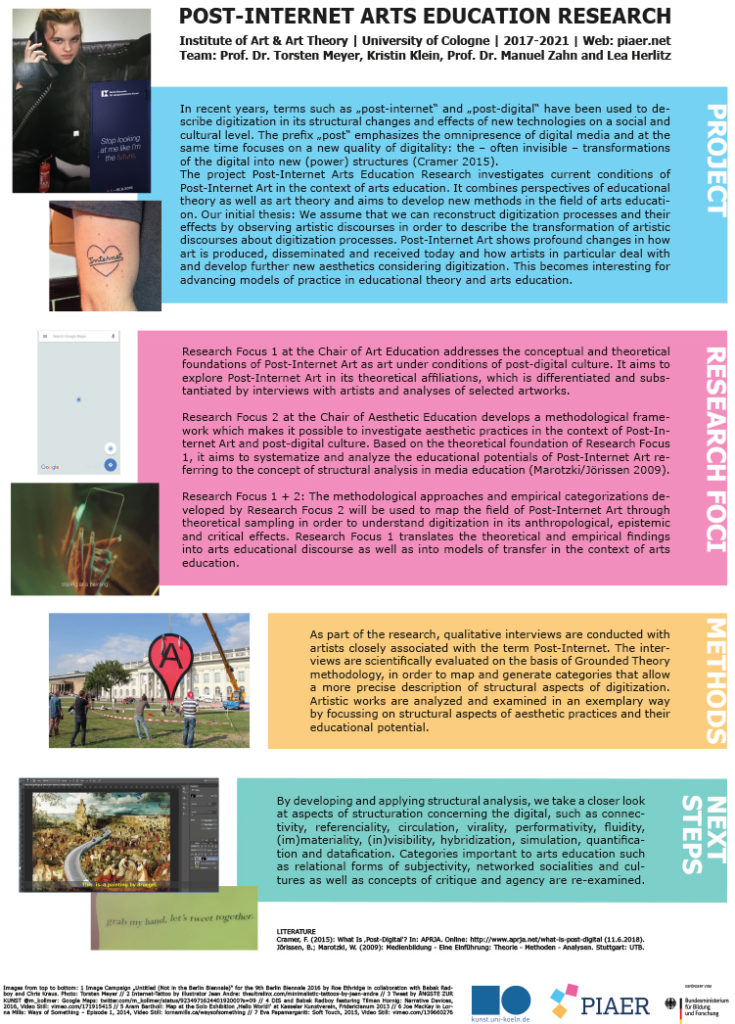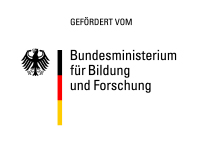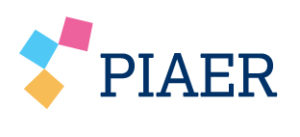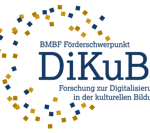Post-Internet Arts Education Research (PIAER)
 About the project Post-Internet Arts Education Research: In recent years, terms such as „post-internet“ and „post-digital“ have been used to describe digitization in its structural changes and effects of new technologies on a social and
cultural level. The prefix „post“ emphasizes the omnipresence of digital media and at the
same time focuses on a new quality of digitality: the – often invisible – transformations
of the digital into new (power) structures (Cramer 2015).
The project Post-Internet Arts Education Research investigates current conditions of
Post-Internet Art in the context of arts education. It combines perspectives of educational
theory as well as art theory and aims to develop new methods in the field of arts education. Our initial thesis: We assume that we can reconstruct digitization processes and their
effects by observing artistic discourses in order to describe the transformation of artistic
discourses about digitization processes. Post-Internet Art shows profound changes in how
art is produced, disseminated and received today and how artists in particular deal with
and develop further new aesthetics considering digitization. This becomes interesting for
advancing models of practice in educational theory and arts education.
About the project Post-Internet Arts Education Research: In recent years, terms such as „post-internet“ and „post-digital“ have been used to describe digitization in its structural changes and effects of new technologies on a social and
cultural level. The prefix „post“ emphasizes the omnipresence of digital media and at the
same time focuses on a new quality of digitality: the – often invisible – transformations
of the digital into new (power) structures (Cramer 2015).
The project Post-Internet Arts Education Research investigates current conditions of
Post-Internet Art in the context of arts education. It combines perspectives of educational
theory as well as art theory and aims to develop new methods in the field of arts education. Our initial thesis: We assume that we can reconstruct digitization processes and their
effects by observing artistic discourses in order to describe the transformation of artistic
discourses about digitization processes. Post-Internet Art shows profound changes in how
art is produced, disseminated and received today and how artists in particular deal with
and develop further new aesthetics considering digitization. This becomes interesting for
advancing models of practice in educational theory and arts education.
Research Foci Research Focus 1 at the Chair of Art Education addresses the conceptual and theoretical foundations of Post-Internet Art as art under conditions of post-digital culture. It aims to explore Post-Internet Art in its theoretical affiliations, which is differentiated and substantiated by interviews with artists and analyses of selected artworks. Research Focus 2 at the Chair of Aesthetic Education develops a methodological framework which makes it possible to investigate aesthetic practices in the context of Post-Internet Art and post-digital culture. Based on the theoretical foundation of Research Focus 1, it aims to systematize and analyze the educational potentials of Post-Internet Art referring to the concept of structural analysis in media education (Marotzki/Jörissen 2009). Research Focus 1 + 2: The methodological approaches and empirical categorizations developed by Research Focus 2 will be used to map the field of Post-Internet Art through theoretical sampling in order to understand digitization in its anthropological, epistemic and critical effects. Research Focus 1 translates the theoretical and empirical findings into arts educational discourse as well as into models of transfer in the context of arts education.
Methods As part of the research, qualitative interviews are conducted with artists closely associated with the term Post-Internet. The interviews are scientifically evaluated on the basis of Grounded Theory methodology, in order to map and generate categories that allow a more precise description of structural aspects of digitization. Artistic works are analyzed and examined in an exemplary way by focussing on structural aspects of aesthetic practices and their educational potential. By developing and applying structural analysis, we take a closer look at aspects of structuration concerning the digital, such as connectivity, referenciality, circulation, virality, performativity, fluidity, (im)materiality, (in)visibility, hybridization, simulation, quantification and datafication. Categories important to arts education such as relational forms of subjectivity, networked socialities and cultures as well as concepts of critique and agency are re-examined.
The following text provides a detailed overview of the project:
Torsten Meyer, Manuel Zahn, Lea Herlitz, Kristin Klein: Post-Internet Arts Education Research (PIAER). Kunstpädagogik und ästhetische Bildung nach der postdigitalen Entgrenzung der Künste. In: Benjamin Jörissen, Stephan Kröner, Lisa Unterberg (Hg.): Forschung zur Digitalisierung in der Kulturellen Bildung. Schriftenreihe Kulturelle Bildung und Digitalität. Band 1. München: kopaed 2019, S. 161-172.
The entire publication is available as open access: https://www.pedocs.de/frontdoor.php?source_opus=18486
Further publications on the project can be found at texts and publications


